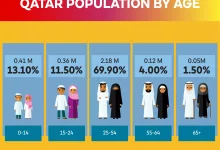The Arab population across the globe is a subject of considerable interest and study. Arab identity is typically associated with the use of the Arabic language, as well as cultural and historical ties to the Arab world. This article provides a comprehensive overview of the estimated number of Arabs worldwide, considering both the countries traditionally classified as part of the Arab world and the Arab diaspora.
The Arab World
The term “Arab world” refers to a group of countries in the Middle East and North Africa (MENA) where Arabic is a predominant language. These countries are:
- Egypt
- Iraq
- Jordan
- Lebanon
- Libya
- Mauritania
- Morocco
- Oman
- Palestine
- Saudi Arabia
- Syria
- Tunisia
- **United Arab Emirates (UAE)
- Yemen
The combined population of these countries provides a starting point for understanding the Arab demographic. According to estimates from various demographic sources, as of the early 2020s, the total population of the Arab world is approximately 450 to 500 million people.
Population Breakdown by Country
- Egypt: With a population exceeding 100 million, Egypt is the most populous Arab country.
- Iraq: Iraq’s population is estimated at around 40 million.
- Jordan: Jordan has a population of approximately 10 million.
- Lebanon: Lebanon’s population is around 7 million.
- Libya: The population of Libya is about 7 million.
- Mauritania: Approximately 4.5 million people live in Mauritania.
- Morocco: Morocco has a population of around 37 million.
- Oman: Oman’s population is estimated at 5 million.
- Palestine: The combined populations of the West Bank and Gaza Strip are around 5 million.
- Saudi Arabia: Saudi Arabia has a population of approximately 35 million.
- Syria: Prior to the Syrian civil war, Syria had a population of about 22 million; current estimates vary significantly due to the ongoing conflict.
- Tunisia: Tunisia’s population is about 12 million.
- United Arab Emirates: The UAE has a population of around 9 million, though a significant portion consists of expatriates.
- Yemen: Yemen’s population is estimated at 30 million, although this figure is affected by the ongoing conflict.
Arab Diaspora
The Arab diaspora includes people of Arab descent who live outside the traditional Arab world. Significant Arab communities are found in countries such as:
- United States: The Arab American population is estimated at around 3 to 4 million, with significant communities in cities like Detroit, Los Angeles, and New York.
- Canada: The Arab Canadian population is estimated to be over 1 million, with notable communities in cities like Toronto and Montreal.
- Brazil: Brazil has a substantial Arab community, particularly of Lebanese and Syrian descent, numbering around 7 million.
- Argentina: Argentina also has a significant Arab population, with estimates around 2 million, primarily of Syrian and Lebanese origin.
- Australia: Australia’s Arab population is estimated at about 700,000, with notable communities in cities like Sydney and Melbourne.
- France: France has a significant North African population, which includes many people of Arab descent, estimated at around 5 million.
Total Estimated Arab Population
Combining the populations from the Arab world and the diaspora, estimates suggest that the total number of Arabs worldwide is around 500 to 600 million. This estimate encompasses both individuals residing in Arab countries and those living abroad who identify as Arab.
Factors Affecting Population Estimates
-
Migration: Patterns of migration, both historical and recent, have influenced the size and distribution of Arab populations globally. Wars, economic opportunities, and political instability have played significant roles in shaping these patterns.
-
Conflicts and Displacements: Ongoing conflicts in the Arab world, such as the Syrian Civil War and the conflict in Yemen, have led to significant displacement and migration. This has impacted the demographic statistics of these regions.
-
Cultural and Linguistic Identity: Arab identity is often tied to the Arabic language and cultural heritage, which may lead to variations in how individuals are counted in different countries. For instance, in countries with large Arab immigrant populations, such as the United States and Canada, estimates of Arab identity may vary based on self-identification and census methodologies.
-
Expatriate Communities: In countries like the UAE and Saudi Arabia, a large proportion of the population consists of expatriates. Thus, the number of Arabs may be lower compared to the total population of these countries.
Conclusion
The number of Arabs worldwide is a dynamic and complex figure influenced by a variety of factors including migration, conflict, and cultural identity. While estimates suggest a total Arab population of around 500 to 600 million, this number is subject to change based on ongoing demographic shifts and developments in the Arab world and diaspora communities. The diversity within this population reflects a rich tapestry of cultures, languages, and histories that span both traditional Arab countries and global diaspora communities.

